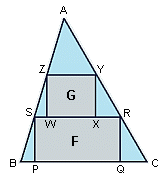
ABC is an acute-angled triangle with area 1. A rectangle F(PQRS) has its vertices on the sides of the triangle, with P and Q on BC, R on AC, and S on AB. Another rectangle, G(WXYZ), has its vertices on the sides of triangle ASR, with W and X on RS, Y on AS, and Z on AR.
What is the maximum total area of F and G?
(In reply to
re: Possible solution by SilverKnight)
I'm pretty sure he intended a parallel to AC, not BC, forming parallelograms with the same areas as F and G, and leaving two similar triangles. Not the same approach I had, but it works, so .. I like it.
=)
|
|
Posted by DJ
on 2004-03-02 14:25:18 |



